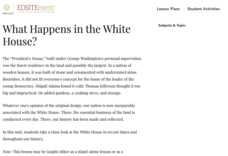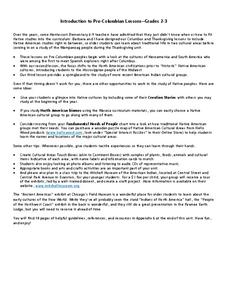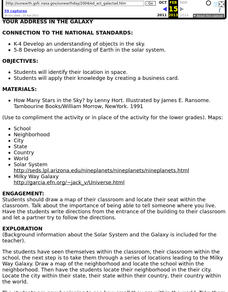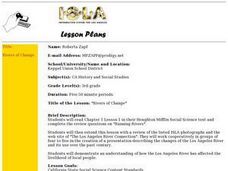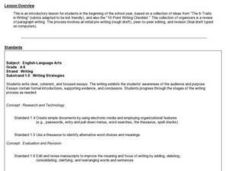Finding Background Information Teacher Resources
Find Finding Background Information lesson plans and worksheets
Showing 776 resources
Teach Engineering
Who Can Make the Best Coordinate System?
Working with a map that does not have a coordinate system on it, small, collaborative teams must come up with a coordinate system for their map. Groups then explain their coordinate structure to the class.
NASA
Development of a Model: Analyzing Elemental Abundance
How do scientists identify which elements originate from meteorites? Scholars learn about a sample of material found in a remote location, analyzing the sample to determine if it might be from Earth or not. They study elements, isotopes,...
C-SPAN
On This Day: Yosemite National Park
Yosemite National Park: Preserving nature's beauty for future generations. An engaging resource provides a series of video clips that shows the importance of creating national parks and the role of the government and US Forest Service....
National Institute of Open Schooling
Periodic Table and Atomic Properties
An in-depth lesson, the fourth activity in a series of 36, begins with teaching how the periodic table's arrangement came to its current design. Using this knowledge, pupils then move on to analyze the arrangement of elements to their...
Reed Novel Studies
Stella By Starlight: Novel Study
Who were the Ku Klux Klan, and what role did they play in the United States during the Great Depression? Using the Stella by Starlight novel study, scholars research the organization and answer questions relating to Sharon M. Draper's...
National Endowment for the Humanities
What Happens in the White House?
Young historians complete a unit of lessons on the functions of the White House. They conduct Internet research, develop a list of activities that take place at the White House, and create a chronological timeline of events at the White...
American Institute of Architects
Architecture: It's Elementary!—Fifth Grade
Young citizens construct an understanding of urban planning in this cross-curricular unit. Covering every aspect of city development from the political, economic, and social influences to sustainable building practices, this...
Florida Department of Environmental Protection
Water, Water Everywhere
Water is one of the most precious resources on the earth. Explore water conservation, the importance of natural resources, and how water is used throughout the globe. Two complete activities along with discussion questions are used to...
Midwest Institute for Native American Studies
Introduction to Pre-Columbian Lessons
Native peoples established civilizations all over Central and North America. Introduce native civilizations with a unit that promotes discussion, reinforces map skills, enhances reading comprehension, and exposes young historians to...
National Park Service
Civil War to Civil Rights: From Pea Ridge to Central High
Explore how the Civil War impacted the Civil Rights Movement. Class members complete a series of projects for a unit that uses a layered curriculum approach to learning.
National Constitution Center
First Amendment Overview Part I
The Declaration of Independence details the natural rights guaranteed by the First Amendment. The video explains these rights, including freedom of speech and non-violent protest. Scholars learn why specific rights were guaranteed and...
NOAA
Ocean Zones
How can organisms light up in water? Bioluminescence is light produced in a chemical reaction that can occur in an organism's body. First, learners determine what happens to light/color as you move into the deep ocean. In groups, they...
Chicago Botanic Garden
Plant Phenology Data Analysis
Scientists monitor seasonal changes in plants to better understand their responses to climate change, in turn allowing them to make predictions regarding the future. The last activity in the series of six has scholars analyze BudBurst...
San Bernardino Co. Supt. of Schools
Was Julius Caesar a Good Leader for Rome?
Learners consider the various perspectives that different groups in Roman society may have had for Julius Caesar, such as Roman soldiers, senators, the working class, and slaves. The primary activity involves a reading of Caesar's...
Curated OER
LET YOUR FINGERS DO THE WALKING
The student will recognize different information sources. 2. The student will use a telephone book as a resource for locating agricultural businesses
and people with agriculture-related jobs.Discuss the purpose of the phone book, and...
Curated OER
Your Address in the Galaxy
Students create a business card after researching their location in space and determining their Galactic Address.
Curated OER
At Home on the Range
Eighth graders explore rangeland uses in Utah. In this Utah rangeland activity, 8th graders read background information on the purposes of rangeland. Students work in groups to create their own ranges using peat. Students discover...
Curated OER
Rivers of Change
Third graders examine rivers and how they affect the people living around them. They read a chapter in their science text, take a virtual river tour online, read a background information story, and in pairs describe the changes in the...
Curated OER
"All About Me" Paragraph
Fifth graders write a paragraph titled "All About Me" in the computer lab after they have drawn graphic organizers to fill in background information about themselves and used a "10-Point Writing Checklist" to do peer editing.
Pulitzer Center
International Aid and Fragile States
"States suffering from internal conflict, weak infrastructures, lack of economic development, and general instability are emerging as a large threat to the international security." What factors contribute to the creation of a fragile...
Chicago Botanic Garden
What Can Tree Rings Tell Us About Climate?
Tree rings are slightly thicker on the south side of the tree because it receives more sunlight. Part two in a series of five lessons helps learners analyze tree rings to determine the environmental conditions that caused size...
National Gallery of Art
Islamic Art and Culture
Provided by the National Gallery of Art in Washington, this resource for teachers examines Islamic art, including calligraphy, arabesques, and geometric designs. A recounting of the spread of the faith and the tumultuous political...
Museum of Science
Wind Turbine
Let the energy blow. Using mostly easily found material such as PVC pipe and fans, pupils build wind turbines. Scholars connect a multimeter to an electric motor to determine the amount of energy generated by their designs. Learners then...
Curated OER
In Katrina's Wake
You will need to go to the National Center for Biotechnology Information website to obtain the article, "In Katrina's Wake." Have your class read it and examine maps of where toxic chemicals were located in Louisiana at the time,...







